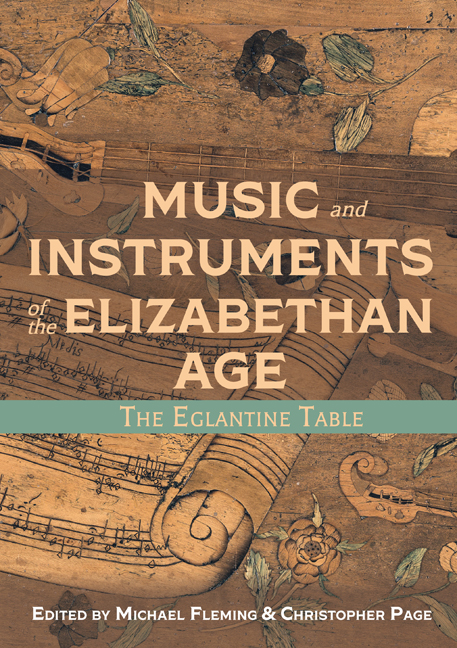Book contents
- Frontmatter
- Dedication
- Contents
- List of Illustrations
- Foreword
- Acknowledgements
- Note to the Reader
- List of Abbreviations
- Introducing the Eglantine Table
- Part I Silent Things
- Part II Music and Instruments
- Part III Broader Views of the Eglantine Table
- Appendices
- Glossary
- Bibliography
- List of Contributors
- Index
- Plate section
6 - The Book of Lute Tablature
Published online by Cambridge University Press: 24 March 2021
- Frontmatter
- Dedication
- Contents
- List of Illustrations
- Foreword
- Acknowledgements
- Note to the Reader
- List of Abbreviations
- Introducing the Eglantine Table
- Part I Silent Things
- Part II Music and Instruments
- Part III Broader Views of the Eglantine Table
- Appendices
- Glossary
- Bibliography
- List of Contributors
- Index
- Plate section
Summary
The Eglantine Table slightly pre-dates what is commonly regarded as the golden age of English lute music represented by players and composers such as John Dowland, Daniel Bacheler, John Johnson, Antony Holborne and Francis Cutting. It was in 1579, for example, that Johnson was appointed at Michaelmas to the place of the Italian Anthony Conti as one of the queen's musicians ‘for the three lutes’. The first two decades of Elizabeth's reign, however – which are of more direct relevance to the Table – brought a quickening interest in the development of such personal accomplishments as lute-playing among the higher and more leisured sections of society. That much is clear from the surviving sources of lute music from England. The late 1550s and early 1560s produced a handful of amateur sources such as MSS Stowe 389 and Royal Appendix 58 in the British Library, Giles Lodge's lute book (now in the Folger Shakespeare Library in Washington, DC) and the Osborn commonplace book (now in the Beinecke Library at Yale University), plus a few odd scraps of material elsewhere. Little of this music is technically demanding, and together these sources reveal a limited grasp of handling and transmitting the system of lute notation called tablature (for which see below). The Stowe manuscript belonged at some point to Ralph Bowle, who admits to being a beginner when he notes that it was ‘writtin by … Ralphe Bowle to Learne to playe on his Lute … The xiij Daie of maye … in anno 1558’. The scribe of Royal Appendix 58 was also a beginner and, as in Stowe, the music there has been added to an existing manuscript that had already known a life as something else – in this case, as a collection of vocal music with texts in English, Latin and French. These books also contain solo instrumental music for other instruments, particularly keyboard, gittern and cittern. The Osborn commonplace book, which also includes poetry, recipes and remedies in hands other than the tablature hand, is the most accomplished of the four books, and some of the pieces have characteristics in common with the Hardwick tablature (Plate 9).
- Type
- Chapter
- Information
- Music and Instruments of the Elizabethan AgeThe Eglantine Table, pp. 101 - 112Publisher: Boydell & BrewerPrint publication year: 2021

